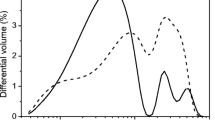Abstract
The thinning effect (deflocculation) in wet-ground highly concentrated composite suspensions (90% bauxite + 10% quartz glass) is studied. The thinning agents used are sodium tripolyphosphate, SB-5 organic plasticizer, and mixtures thereof. Maximum thinning effect is attained with a composite organic mineral additive (20 – 35% SB-5 + 65 – 80% sodium tripolyphosphate). Optimum concentration of the additive is found to be 0.08 – 0.1%, or 0.4 – 0.5 mg/m2 solid-phase surface. At optimum composition and additive concentration, the thixotropic dilatant flow regime of HCBS changes to a dilatant flow regime with a sharp decrease in viscosity and an increase in density of cast preforms. A mechanism for the thinning effect due to additives is considered.
Similar content being viewed by others
REFERENCES
Yu. E. Pivinskii, “New refractory castables and binding systems — guidelines for development, fabrication, and application of refractories in the 21th century, ” Ogneup. Tekh. Keram., No. 2, 4–13; No. 3, 15 – 24; No. 4, 12 – 18 (1998).
Yu. E. Pivinskii, Unshaped Refractories. Book 1. Basics of the Technology [in Russian], Teploénergetik, Moscow (2003).
S. Banerjee, Monolithic Refractories. A Comprehensive Handbook. World Scientific, Singapore – New Jersy – London – Hong Kong (1998).
A. J. Milan, C. A. Gutierrez, M. I. Nieto, et al., “Aging behavior of alumina casting slip, ” Amer. Ceram. Soc. Bull., No. 5, 64–68 (2000).
I. R. Oliveira, P. Sepulveda, and V. C. Pandolfelli, “Deflocculation of Al2O3 – SiC suspensions, ” Am. Ceram. Soc. Bull., 80(2), 47–5 (2001).
A. R. Studart and V. C. Pandolfelli, “Dispersants for high-alumina castables, ” Am. Ceram. Soc. Bull., No. 4, 36–44 (2002).
Yu. E. Pivinskii, Theoretical Aspects in the Technology of Ceramics and Refractories. Selected Works, Vol. 1 [in Russian], Stroiizdat, St. Petersburg (2003).
V. G. Batrakov, Modified Castables. Theory and Practice [in Russian], Stroiizdat, Moscow (1998).
N. A. Shapovalov, V. A. Lomachenko, M. M. Latypova, et al., “Plasticizing additives synthesized from by-products (bottoms) in the production of resorcinol, ” Nauka — Proizvodstvu, No. 3, 20–22 (2001).
E. V. Krivokorytov, N. V. Kononov, D. S. Osipchik, and B. I. Polyak, “Nonfired periclase-carbon refractories based on a thermoreactive polymer binder, ” Ogneup. Tekh. Keram., Nos. 1 – 2, 19–24 (1999).
A. A. Petrov, Kh. V. Ban'yan, and A. T. Trishchenko, Organic Chemistry (ed. M. D. Stadnichuk) [in Russian], Ivan Fedorov Publishers, St. Petersburg (2002).
O. V. Mukhachev, A High-Strength Castable with SB-5 Superplasticizer Based on Resorcinol-Furfurol Oligomers, Author's Abstract of Candidate's Thesis [in Russian], Belgorod (2000).
D. Napper, Polymeric Stabilization of Colloidal Dispersions, Academic Press, London (1983).
Yu. E. Pivinskii and D. A. Dobrodon, “Preparation and properties of binding high-alumina suspensions in the bauxite – quartz glass system, ” Novye Ogneupory, No. 5, 19–26 (2002).
E. M. Grishpun and Yu. E. Pivinskii, “Highly concentrated ceramic binding suspensions (HCBS) and ceramic castables — a breakthrough in the refractory technology of the 21st century, ” Novye Ogneupory, No. 2, 28–33 (2002).
Yu. E. Pivinskii, Ceramic Binders and Ceramic Castables [in Russian], Metallurgiya, Moscow (1990).
Yu. E. Pivinskii, The Rheology of Dilatant and Thixotropic Disperse Systems [in Russian], St. Petersburg State Technological Institute (Technical University), St. Petersburg (2001).
Yu. E. Pivinskii, “Effect of porosity and hydration on the sintering of ceramic materials, ” Ogneupory, No. 3, 14–21 (1985).
V. F. Kaplan, Yu. E. Pivinskii, and A. N. Saprykin, "Dilatant hardening of quartz-glass dispersions," Kolloidn. Zh., 50(6), 1092–1099 (1988).
Yu. E. Pivinskii, “Stabilization and aging of ceramic suspensions, ” Ogneupory, No. 8, 15–22 (1983).
Author information
Authors and Affiliations
Rights and permissions
About this article
Cite this article
Pivinskii, Y.E., Ermak, Y.N., Cherevatova, A.V. et al. The Effect of Thinning Agents on Rheological and Technological Properties of the Bauxite HCBS System. Refractories and Industrial Ceramics 44, 169–174 (2003). https://doi.org/10.1023/A:1026356302096
Issue Date:
DOI: https://doi.org/10.1023/A:1026356302096




